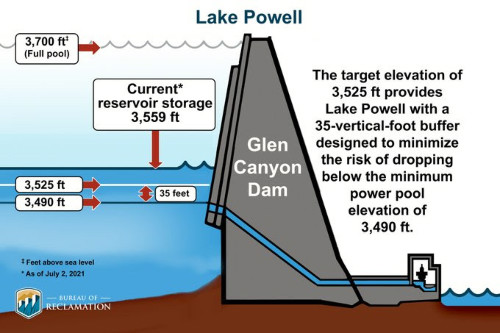
| ABOUT | ARTICLES | FORUM | RESOURCES | GALLERY | CROSS |
 |
|
|||||||||||||
|
||||||||||||||
|
Talk about this article... Part Two: Preparing Comments for Public Participation During the Reconsultation of Interim Guidelines July 24, 2021  Hydropower cessation at Glen Canyon Dam is possible in Year 2022 This Section is Part Two
__________________________________________________________________________ PART TWO: Narratives Old and New
### On The Colorado Narrative: It could be said that movements to create sustainable and resilient communities—which include functional ecosystems—are considered unAmerican, if not illegal, in the sense that legislators have yet to acknowledge that the planet's natural resources have transitioned from abundance, to scarcity and uncertainty. Moreover, that this transition period will carry a sizeable investment package and that cooperation with other states and sovereigns will be difficult (Griggs, 2014). That moving through this transition period, to unravel very complex issues, will require many decades of persistent hard work. This is why this country will need to develop an ethical national water policy, which was attempted in the mid-1960s and early 1970s, and with very limited success.
The purpose of 2007 Interim Guidelines was to generate a process in which shortage declarations could be avoided for the seven states of the Colorado River Basin (CRB) and Mexico, and simultaneously continue to be generous about providing more water uses for more people, and without changing the Law of the River. In other words, the proposed solution was a circle back. Therefore, it is reasonable to conclude that to have sustainibility in the CRB, the growth paradigm is no longer feasible and the Law of the River must be changed. In 2014 it was recognized that program accomplishments were insufficient and 5-years later the seven states and Mexico finally entered into emergency drought contingency planning contracts and treaty minutes, which also has not yet accomplished positive results, because mandatory shortages begin in January 1, 2022 for Arizona, Nevada and Mexico, and the amount of that shortage is 613,000 acre-feet (the monthly average of water passing through the turbines at Glen Canyon Dam is 685,833 acre-feet). Further cutbacks and hydropower cessation could happen in Water Year 2022 (October to September), should the basin's hydrology continue to be impacted by heat traps, dry soils, increased consumption by thristy plants and people, and all due to disrupted circulation patterns of ocean and atmosphere. What this means is that the approaches of the last 14-years, which truly range from kick-the-can to gradualism, are not the energetic strategies required to inspire the public's trust toward management in the Colorado River Basin; the very river management paradigm that the rest of the world has decided to emulate. The essence of the problem is the Colorado River Compact of 1922 and the language of compromise that it contains; it is an unfinished document; it was the best effort under the circumstances of it's time; it is a document destined for circle back discussions. Though this formative document has never been changed, a compilation of surrogate laws, agreements and policies were created and called, at first, "The Hoover Dam Documents," and now more commonly called, "The Law of the River." This layered stack of legal papers has not solved the water security problems of our times, and neither do the public laws and codes of the state and federal governments. In other words, we just aren't prepared for the pace of change that is quickening with every passing decade.The single-most controversial topic of 1922 was the water budget of the entire Colorado River Basin. The deficits that were intentionally embedded into this document still remain the dominate issue today, after four generations of passing time. The second issue was how will the real-time water budget, which is variable by decade and century, be equitably allocated amongst the seven states, Mexico, the tribes, and wildlife. See: OTC Discussion about Northcutt Ely, co-author of the Hoover Dam Documents. Why is this so difficult? Everybody knows how to balance a checkbook and create a household budget, and everybody understands the consequences when acccidental and deliberate blunders occur. What this history suggests is that the principle of precautionary planning was not addressed at the front ends of these negotiations, and that the back end negotiations are merely ineffectual stop gap measures that waste money and time. "Creative" water marketing contracts and various engineering solutions to augment the supply have been proposed, but it is vitally important to understand that the completion of these solutions will take many decades to implement, and then, it is highly likely that the water budget will be exceeded yet again, and yet another circle back. This is why sustainibility and resilency goals are just words, rather than vigorous action items. If substanative reform does not happen in the next five years, then the basin's only assurrance is this: it works, until it doesn't. This is also known as reckless abandon and if it does unravel, it is entirely deserved. The Eventualities and Imperatives
In the 21st century, this imbalance has grown negative 1 million acre-feet per decade.
HISTORY OF CLIMATE DISRUPTION
This page is Part Two (narratives old and new)
Talk about this article... |
| ||||